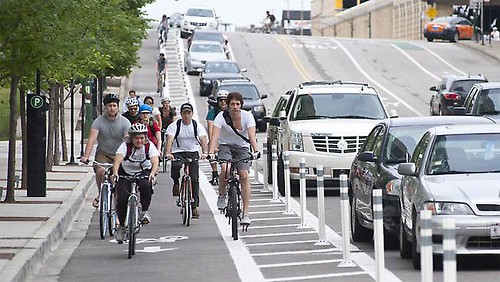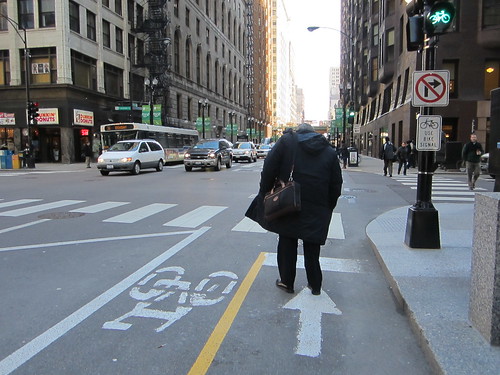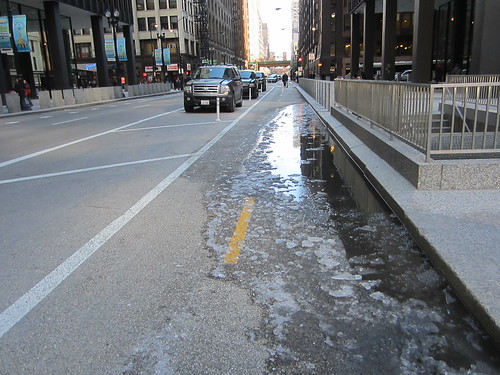As Steven Vance wrote recently, protected bicycle lanes will be crucial for boosting Chicago’s bike mode share because they attract the “interested but concerned” set that doesn’t yet feel comfortable riding on city streets. But as the city installs protected lanes on roadways that are already popular bike routes, such as Milwaukee Avenue, it will be important to design and maintain the new lanes so that they appeal to current riders as well.
Many "enthused and confident" riders have said they prefer buffered bike lanes to the city’s existing protected lanes due to design and maintenance issues. Others may avoid riding in protected lanes no matter what. So to avoid a backlash from cyclists grumbling that their favorite routes have been ruined, the city should build and maintain protected bike lanes so that the current complaints are addressed. The new street configurations should also allow speedy cyclists to safely ride outside the lanes if they choose, which Chicago Department of Transportation staffers recently said is a legal option.
We've heard criticisms of the existing protected lanes in person from a number of bike riders. And during a discussion of buffered and protected lanes on The Chainlink, a local online bike forum with over 8,500 members, ten different commenters, the majority, said they prefer the former, for a number of reasons discussed below.
At last week’s Mayor’s Bicycle Advisory Council meeting, CDOT staff fielded questions about several of these design and maintenance issues with responses that suggest these issues are on their radar and they plan to take action on them. Here are some of the complaints about the existing lanes, along with some possible solutions. The following photos were taken yesterday during a ride downtown on the Elston Avenue, Kinzie Street and Dearborn Street protected lanes.
Complaint: Protected lanes make it harder for faster bicyclists to pass slower ones. “I don't like infrastructure that prevents me from passing,” said a Chainlink commenter who called himself "Joe Schmoe." “I'm trying to make good time to get back home, and I don't like to wait behind slow cyclists.”
Solution: Build wider lanes. CDOT Project Manager Mike Amsden recently told Streetsblog that the five-foot minimum width for protected lanes won’t be sufficient on Milwaukee, so the agency wants to build wider lanes with plenty of room for passing.
Complaint: When motorists drive or park in protected lanes, cyclists can be trapped. “I really don't like the idea of being sandwiched between the curb and parked cars,” said Chainlink member "Tricolor."
Solution: Bollards at the entrances to the lanes; better enforcement. At the MBAC meeting CDOT Commissioner Klein implied CDOT will be experimenting with different bollard configurations. “I think you’ll see some changes [this] year.”
Complaint: There's an increased danger of cyclists being struck by turning vehicles due to poor sightlines. “Conflicts with turning cars are made worse by the row of parked cars blocking cyclists' and drivers' views of each other,” said Chainlink commenter Cameron Puetz.
Solution: Dedicated bike traffic signals. These are standard on protected bike lanes in Europe, and CDOT successfully piloted them on Dearborn last year. Although fast cyclists may complain that the bike stoplights slow them down and may disregard them, they’ll make conditions much safer for those who obey them.
Complaint: Pedestrians walk in protected lanes and stand in them while waiting to cross the street.
Solution: Warning signs and markings; outreach to peds via the Bicycling Ambassadors and advertising. Last week Amsden said CDOT will be repainting “Look” stencils on the street, adding green pavement at intersections, and the ambassadors will be doing more outreach.
Complaint: Curbside pavement slopes toward the gutter and tends to be poor quality.
Solution: Build wider lanes so cyclists can ride further from the curb; better pavement maintenance. At the MBAC meeting Amsden said CDOT will no longer be installing bike lanes on poor quality asphalt and lanes will be striped as part of repaving projects whenever possible. Klein said divots along the Dearborn lanes that currently fill up with water and ice will be patched in the near future.
Complaint: Protected lanes are more likely to accumulate gravel, glass, garbage and snow.
Solution: Regular street sweeping and snow plowing. Last week Klein said CDOT has taken over plowing duties from Streets and Sanitation, and outreach to building manager could prevent snow from being shoveled from sidewalks into the lanes.







